Table of Contents
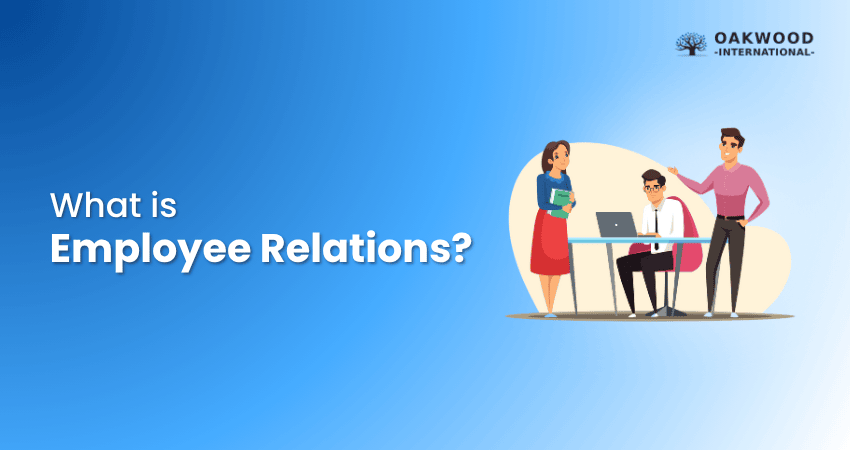

Want to create a workplace people are proud to be part of? A place where morning meetings feel energising, teammates lift each other up, and Mondays come with a smile? Employee Relations can make it happen! Think of it as the heartbeat of a happy workplace.
When people feel heard, respected, and included, they bring their best selves to work. So, in this blog, we’ll explore what Employee Relations means, why it matters, and how to make it work for your team. Dive in without any delay!
Table of Contents
What is Employee Relations?
Why are Employee Relations Important?
Examples of Employee Relations Issues
How to Handle Employee Relations Issues?
Tips for an Effective Employee Relations Strategy
How to Implement an Employee Relations Policy?
Conclusion
What is Employee Relations?
Employee Relations (ER) refers to the relationship between employees and employers. It covers how well they communicate, collaborate, resolve issues, and work together to achieve shared goals. It includes all interactions of both positive and negative things throughout the employee's lifecycle.
Good Employee Relations creates a positive, respectful, and inclusive workplace. It helps improve job satisfaction, boost productivity, and reduce staff turnover. Moreover, it is a key function that involves managing both day-to-day interactions and complex workplace issues.
Why are Employee Relations Important?
Strong Employee Relations bring many benefits for both the employee and the employer. Here are some of the key benefits of Employee Relations and why it is important for your business or company:
Increased Employee Satisfaction: When employees feel heard and valued, they’re more likely to stay engaged.
Better Communication: Clear, open dialogue between employees and management prevents misunderstandings.
Higher Productivity: Positive work relationships motivate employees to perform better.
Reduced Conflict: Proactive ER helps resolve issues early, reducing escalation.
Lower Absenteeism and Turnover: Employees are more loyal when their concerns are addressed.
Compliance and Legal Safety: Managing ER helps ensure legal compliance, reducing the risk of disputes and tribunals.
Enhanced Employer Brand: Companies known for good Employee Relations attract better talent.
Examples of Employee Relations Issues
There are many different situations that can lead to Employee Relations issues. Here are some common issues:
1. Employee Misconduct
Misconduct includes any behaviour that violates the policies of a company or expected conduct. This means doing something wrong at work, like being rude, stealing, lying, or breaking rules. The common incidents include:
Accessing confidential files without permission
Repeatedly arriving late despite warnings
Using offensive language toward a colleague
2. Employee Wellbeing
When employees face mental health issues like feeling tired, stressed, or experiencing burnout, it affects their performance and morale. Therefore, it is important to care about their mental health, work-life balance, and overall happiness at work.
A high rise in your employees’ sick days if there are no wellness policies
Stress and burnout lower productivity and motivation
Support can include mental health resources and flexible hours
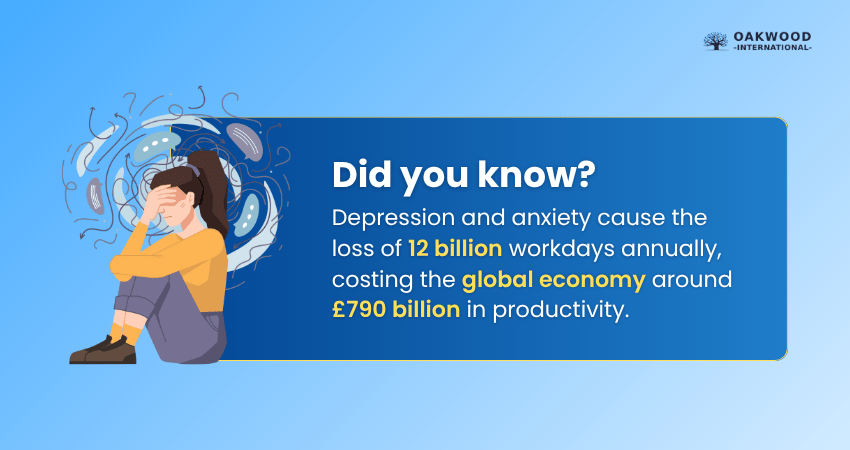
3. Workplace Health and Safety
Health and safety concerns in the workplace should be the top priority to increase the employee retention rate and significantly reduce turnover. Unsafe equipment or workspaces can cause discomfort and accidents. So, you need to follow safety rules and provide training.
Regular risk assessments should be conducted
Proper equipment and training are precautionary measures
A safe workplace builds employee trust and confidence
Effectively manage legal challenges and workplace disputes with our Employment Law Training – Register today!
4. Labour and Industrial Relations
The labour and industrial relations include how employers work with unions or employee representatives. It is a formal relationship between them. Issues like pay or work conditions are discussed here. Good communication is key to maintaining a continuous workflow. It includes:
Concerns around pay, working hours, and contracts
Disputes can lead to strikes or legal action
Formal negotiation processes are often required
5. Employee Onboarding
This is the initial process of welcoming and training new employees. It involves introducing them to their respective team to make them comfortable with their work. A poor experience can leave new hires confused or unhappy. Good onboarding makes them feel more confident.
Should include clear role expectations and training
Helps new employees feel supported and confident
Positive onboarding improves engagement and retention
6. Workplace Conflict Management
Disagreements happen in every workplace. They are so common that everyone will have their own opinions and perspectives. So, conflicts between colleagues, teams, or Managers are normal but need to be carefully managed. Unresolved conflict can lead to resignations.
Causes stress, low morale, and reduced teamwork
Encouraging open communication can prevent conflicts
Should be resolved quickly and fairly
7. Absenteeism
Frequent, unexplained absenteeism of employees may signal deeper problems like burnout, disengagement, or personal issues. Finding and addressing this early helps fix the problem before it grows.
Impacts workload balance and team morale
Requires regular tracking and open discussions
Early action can reduce long-term absence
8. Insubordination
Insubordination refers to an employee deliberately refusing to follow reasonable instructions or showing disrespect to authority such as Managers. These incidents need to be addressed professionally, following fair disciplinary procedures.
Can harm team harmony and manager credibility
Often includes verbal defiance or ignoring tasks
Must be handled with formal warnings if needed
Implement compliance with equality legislation with our Direct and Indirect Discrimination Training – Start your journey immediately!
How to Handle Employee Relations Issues?
Employee Relations problems can come up in any workplace. To deal with them well, you need to have a clear plan, treat everyone fairly, and act quickly. Here are some simple steps to follow:
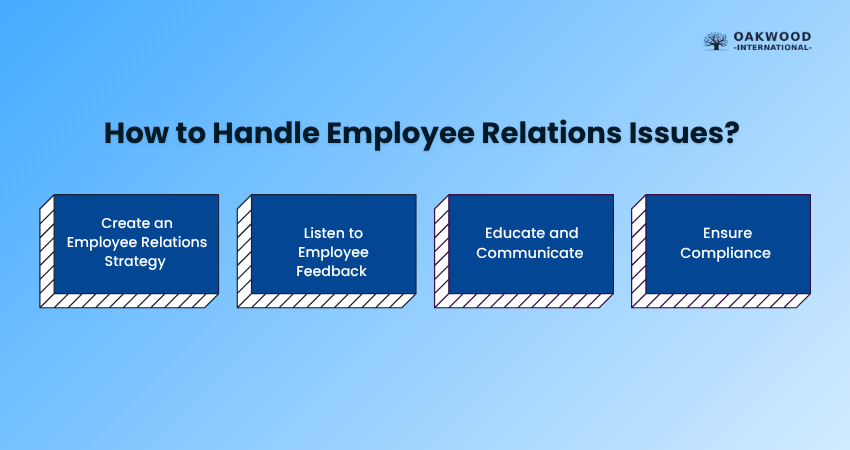
1. Create an Employee Relations Strategy
A strategy is a plan that helps keep both employers and employees happy. While the company wants good performance, employees want to feel valued and supported. A good Employee Relations plan helps meet both needs. Your plan needs to include how you’ll handle problems, reward good work, and measure how things are going.
2. Listen to Employee Feedback
Communication is not one-way; instead, it is two-way, involving listening and speaking. Therefore, you need to actively listen to others. When someone brings up a problem, give them your full attention. Try not to interrupt when someone is speaking, and try to understand how they feel. Let them know you’re listening by taking action and updating them about any changes.
3. Educate and Communicate
It is always better to educate oneself to avoid making mistakes. Therefore, make sure your employees understand the rules and what is expected of them. When everyone knows how to act, there won’t be many problems. Be clear, fair, and consistent while educating about something
4. Ensure Compliance
Follow legal guidelines and internal policies consistently. Even minor issues, when recorded properly, can provide useful context. For that, always keep records of employee issues and how they are handled. If a complaint turns into a legal matter, good records will help protect the company and the employees.
Tips for an Effective Employee Relations Strategy
So far, you might have an idea of how Employee Relations works and how it affects your business. Now, let’s check some tips for an effective Employee Relations strategy:
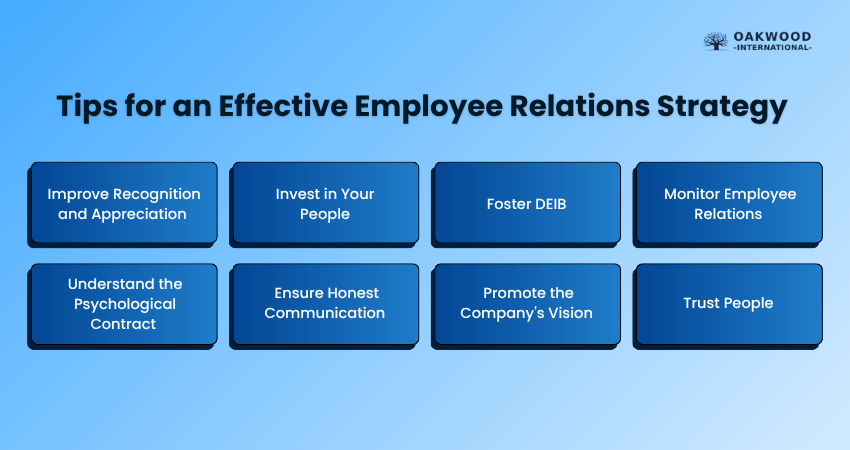
1. Improve Recognition and Appreciation
Employees feel valued when their efforts are noticed. On the other hand, recognition boosts morale, teamwork, and motivation. The reason behind this action is that recognition is one of the top drivers of Employee Engagement and better performance.
Celebrate wins in team meetings or company-wide events
Use peer-to-peer shoutouts like “Cheers for Peers”
Make appreciation frequent, specific, and heartfelt
Grab the opportunity to learn strategic planning and Resource Management with our Workforce Resource Planning Training – Sign up soon!
2. Invest in Your People
Supporting both the personal and professional growth of employees can help you retain talented people and boost productivity. People stay longer and work better when they feel and see that their growth is a priority.
Offer training, mentorship, and learning opportunities
Provide flexible schedules to allow time for development
Promote wellbeing with wellness programmes and mental health support
3. Foster DEIB
DEIB stands for Diversity, Equity, Inclusion and Belonging. This is used to create a workplace where everyone feels respected, represented, and heard. Simultaneously, it leads to stronger collaboration, creativity, and employee satisfaction.
Encourage diverse voices in team decisions and leadership
Provide bias and inclusion training for all employees
Give voice to underrepresented groups in decision-making
4. Monitor Employee Relations
You can monitor and measure how Employee Relations is performing using data and feedback. This data helps spot trends, prevent issues early, and measure progress. Here is how you can track and evaluate how your Employee Relations strategy is working:
Measure engagement, turnover, absenteeism, and complaints
Use surveys and feedback tools for honest insights
Respond to feedback and make improvements visible
5. Understand the Psychological Contract
The psychological contract is a kind of unwritten expectation between employer and employee. If either side breaks promises, it questions the trust maintained. To be on good terms, you need to be honest and clear about what is expected.
Keep promises made during recruitment or reviews
Address mismatched expectations before they cause disengagement
Be clear about what employees can expect
6. Ensure Honest Communication
Encourage open, two-way communication at all levels. The leaders need to listen actively and provide constructive feedback. This improves trust and fosters engagement. In general, clear and open communication is the key to reducing misunderstandings and building trust.
Encourage feedback and questions from employees
Create safe spaces for open communication and differences of opinions
Share updates promptly, even the hard news
7. Promote the Company's Vision
Employees should feel that they are contributing something meaningful to the company or organisation they work for. So, to maintain that, you can share the company mission regularly and show how every team contributes to success. This improves alignment and motivation.
Share the company’s mission, values, and goals regularly
Highlight how every role contributes to success
Involve employees in goal-setting and planning
8. Trust People
To build positive Employee Relations, you need to trust them to do their job and let them take responsibility for their own actions. Avoid watching their every move in this process. Trust makes them feel confident, innovative, accountable, and respected.
Train Managers to support, not micromanage
Recognise independence and responsible decision-making
Set clear expectations, then let them deliver
Aim for continuous improvement, ensuring long-term growth and resilience with our Human Capability Development Program Course – Begin anytime!
How to Implement an Employee Relations Policy?
Creating an effective Employee Relations policy is a key step in shaping a respectful, fair, and productive work environment. A well-structured policy helps prevent misunderstandings, resolve issues quickly, and ensure everyone understands their rights and responsibilities. So, here is how you can implement it:
1. Understand Your Organisation’s Mission and Vision
Start by clearly identifying the mission and vision of your business. Your Employee Relations policy should reflect these values and help employees see how their roles connect to the bigger picture.
Align the Employee Relations policy with your company’s long-term goals
Make sure employees understand how their work supports those goals
Refer to your mission and values throughout the policy
2. Define the Purpose of the Policy
Be clear about why this Employee Relations policy exists. You can give an outline of how it supports a positive work culture, resolves issues, and promotes fairness. It also helps with what to expect and how to handle concerns respectfully and consistently.
Include a brief introduction about the company’s commitment to the policy
Explain how the policy benefits both employees and management
Emphasise that it’s part of creating a safe, inclusive, and collaborative environment
3. Tailor the Policy to Your Business
Your policy reflects your business culture, size, sector, and location. It is not the same for every business. So, consider the challenges your teams face and the type of support your employees need. Make sure the language used is easy to understand and relevant to your workplace.
Consider your workplace demographics, structure, and communication styles
Adjust policies to suit whether you're a remote, hybrid, or office-based team
Consult legal advisors to ensure alignment with regional employment laws
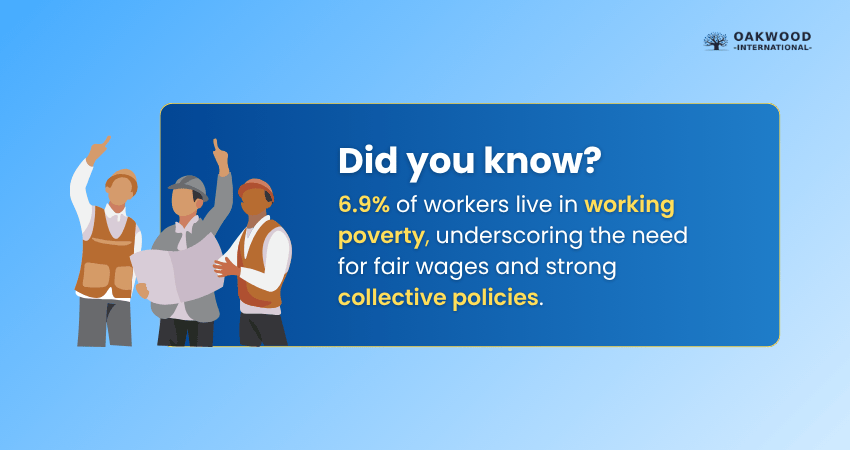
4. Outline Clear Procedures and Guidelines
Inform everything beforehand itself. It not only includes the introduction of their team but also the procedures and guidelines of the company. You need to clearly explain how your organisation will handle various employee-related situations.
Include steps for handling grievances, misconduct, conflicts, and feedback
Define the responsibilities of employers and employees
Set timelines and escalation points for complaints or concerns
5. Communicate the Policy Effectively
Whatever policy has been created, it should be in an understandable format for the employees. You need to use plain language, so everyone, regardless of their role, can easily follow it. Encourage questions and feedback to make sure it's clear and practical.
Share it during onboarding and keep it available via internal systems
Train Managers and team members on how to apply it consistently
Use meetings, FAQs, and visuals to explain key sections clearly
6. Include Core Engagement Principles
Successful Employee Relations policies go beyond rules by focusing on relationships. They promote trust, open communication, fairness, and mutual respect across all levels of the organisation. Make sure your policy encourages active listening and regular feedback.
Encourage two-way feedback between employees and management
Reward good work and highlight alignment with company values
Promote open communication and regular check-ins
7. Ensure Legal Compliance
All policies are subject to compliance with labour laws and industry regulations. For that, you can regularly review your policy to keep up with legal updates and changes in employment standards. Outline employee rights and employer responsibilities within the policy.
Include sections on wage laws, discrimination, health and safety, and dismissal
Update the policy regularly to reflect legal changes
Let employees know their rights, benefits, and available support channels
8. Monitor, Review, and Improve
An Employee Relations policy is a living document because it grows with your business. You need to check if the policy is still effective by collecting feedback and reviewing any workplace issues. Involve both managers and employees to make sure the policy stays practical and fair.
Schedule regular reviews (e.g., annually or bi-annually)
Use employee feedback, HR data, and incident reports to inform updates
Be open to suggestions for improving clarity or fairness
Conclusion
Building strong Employee Relations isn’t just about handling problems. It is more about creating a workplace where people feel respected, supported, and inspired to do their best. By listening to employees, promoting fairness, and setting clear policies, organisations can foster trust, boost morale, and reduce conflict. When people thrive, so does business.
Drive team success and the culture of collaboration with our Successful People Management and Team Leadership Training – Join now!


 Back
Back



 Back to Catagories
Back to Catagories





 + 44 7452 122728
+ 44 7452 122728










